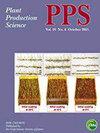土壤水分变化对不同绿茎病严重程度大豆品种营养贮藏蛋白积累的影响
IF 1.3
3区 农林科学
Q2 AGRONOMY
引用次数: 1
摘要
绿茎失调(GSD)以种子成熟过程中茎衰老延迟为特征,在大豆生产中使收获复杂化。虽然GSD与汇源不平衡有关,但对GSD的快速而精确的评估尚未建立。在有库限制的大豆植株中,营养储存蛋白(VSP)不断积累。本研究通过盆栽和田间试验,重新评价了日本京都地区2年多来土壤水分变化引起的GSD、汇源失衡和VSP积累之间的关系,VSP积累可能是GSD的一个指标。短生育期品种Yukihomare在R1(开花期)、R3(开始结荚期)和R5(开始结籽期)的盆栽中分别进行4周的干旱处理,两年的库大小均有所降低,但相对库质量(荚果重/茎重)有所降低,且GSD的严重程度仅在2017年有所增加,说明受土壤水分影响的库源失衡可导致GSD。在R5(2018)或R5(2019)前15天至R5后28天,灌水或不灌水稻田从R3或R5前后至成熟期的土壤湿度变化倾向于改变GSD的严重程度,但不改变最上部完全展开叶片的VSP积累。然而,两个对照品种大稻和东北129对GSD和VSP的响应存在差异,表明VSP在GSD评价中具有潜在的可用性。图形抽象本文章由计算机程序翻译,如有差异,请以英文原文为准。
Analysis of vegetative storage protein accumulation in soybean cultivars expressing different green stem disorder severity affected by soil moisture change
ABSTRACT Green stem disorder (GSD), characterized by delayed stem senescence during seed maturation, complicates harvesting in soybean production. Although GSD is associated with a sink – source imbalance, a rapid and precise evaluation of GSD has not been established. In sink-limited soybean plants, vegetative storage protein (VSP) accumulates. In this study, pot and field experiments were conducted to reevaluate the relationship between GSD, sink – source imbalance caused by soil moisture change, and VSP accumulation as a possible indicator of GSD in Kyoto, Japan over two years. Drought treatment for four weeks from R1 (beginning flowering), R3 (beginning pod), or R5 (beginning seed) growth stage in pots using the short growth-period cultivar Yukihomare reduced sink size in both years, but reduced relative sink mass (pod weight/shoot weight) and increased GSD severity only in 2017, suggesting that sink-source imbalance, affected by soil moisture, can induce GSD. Soil moisture change from around R3 or R5 to maturity in fields using trench-filled or unfilled water tended to change GSD severity but not VSP accumulation in the uppermost fully expanded leaves from R5 (2018) or 15 days before R5 (2019) to 28 days after R5. GSD and VSP responses, however, differed between the two contrasting cultivars, Tachinagaha and Touhoku 129, suggesting the potential usability of VSP for GSD evaluation. GRAPHICAL ABSTRACT
求助全文
通过发布文献求助,成功后即可免费获取论文全文。
去求助
来源期刊

Plant Production Science
农林科学-农艺学
CiteScore
5.10
自引率
4.00%
发文量
27
审稿时长
>36 weeks
期刊介绍:
Plant Production Science publishes original research reports on field crops and resource plants, their production and related subjects, covering a wide range of sciences; physiology, biotechnology, morphology, ecology, cropping system, production technology and post harvest management. Studies on plant production with special attention to resource management and the environment are also welcome. Field surveys on cropping or farming system are also accepted. Articles with a background in other research areas such as soil science, meteorology, biometry, product process and plant protection will be accepted as long as they are significantly related to plant production.
 求助内容:
求助内容: 应助结果提醒方式:
应助结果提醒方式:


